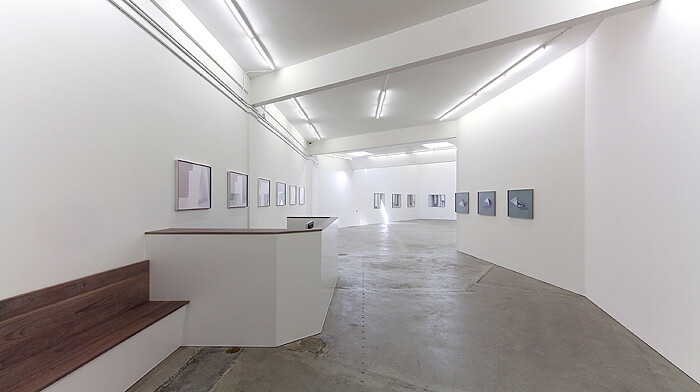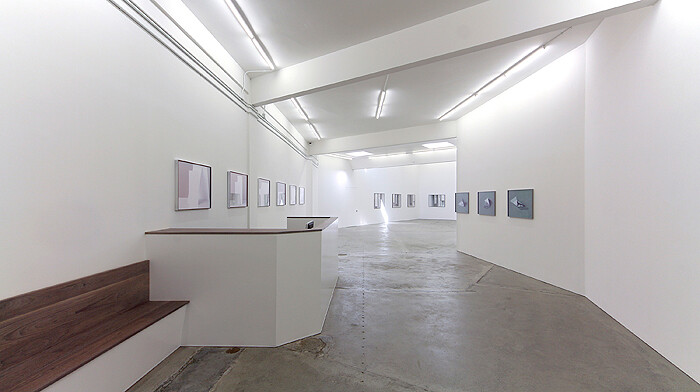Stepping into Ratio 3’s new space on Mission Street in San Francisco and encountering Miriam Böhm’s austere photographs involves no small amount of perceptual and cultural reorientation. On Mission Street, inner-city kids, leftist bohemians, young hipsters, and day laborers move through a stretch of San Francisco populated by taquerías, Chinese take-out joints, discount stores, beauty salons, panaderías, Latino groceries, and high-end bistros. The gallery’s former life was as Darlene’s Fabrics, sandwiched between a Foot Locker and a Money Mart; now the entire storefront has been painted matte black, including windows and doors. Minimal gallery signage in subdued white lettering gives no indication for whom or what this space, so alien to the visual cacophony of the street, might be. The interior’s poured concrete floors, bright florescent lighting, and severely angled, off-kilter white cube architecture are unusual for San Francisco, though less so for Chelsea or Berlin.
Böhm has installed her photographs with sensitivity to this architecture, which is why I draw attention to it here. On view are five sets of photographs, each hung as a discrete grouping in a straight line. The hang, however, responds to the architecture in quirky ways: Böhm placed the first photograph in the series Reference (all works 2012) just above the counter of the (rather high) reception desk, and hung the remaining five photographs too high as well. On the opposite wall, a series of eight photographs titled Match wraps around the gallery wall, with one image precisely aligned with the wall’s edge and another with the doorway. At the back of the gallery, four photographs in the series Prospect are placed off to the left, leaving an expanse of gallery wall to the right empty. The overall effect is one of exactitude: the precision of alignment, the logic of geometry, the asceticism of repetition. In this muted, monastic atmosphere there is an unspoken requirement of close and careful observation. What, then, are we asked to see?
Like Eileen Quinlan or Sara VanDerBeek, Böhm’s photographic practice takes place in the studio, not on the street, which accounts for its hermetic intimacy, its whiff of a Giorgio Morandi still life. She photographs arrangements of simple objects, prints the image, and then uses the print as another component or object in a subsequent arrangement. The series Reference aptly illustrates this process: a piece of white foamcore is placed on a white surface and photographed against a taupe studio backdrop. Later, another piece of foamcore is placed on top of this photographic print, and re-photographed. That image is printed, meticulously framed, and installed in the gallery. The show’s title may refer to this process: an object is placed in front of an earlier image, but what about the before? I think I understand how Reference was made, though I may be wrong. Puzzling over how these images came to be is part of the pleasure they provide, and labor that they require. There are games of decipherment on offer, an old art-historical enjoyment.
Match is one of the most visually stunning and perplexing series on view. Here Böhm introduces color and texture: the background is a kelly green fabric whose warp and weft of green and white threads are clearly visible in the high-resolution image. There is, in fact, nowhere for anything in these images to hide. The object placed on this green field is a folded piece of paper hand-painted with a forest scene—glimpses of blue sky, green leaves, and brown tree trunks emerge through the run of the series like scraps of visual evidence. The forest also appears in the series Interlude, albeit in storybook form. Some of Böhm’s earlier photographs are of brown kraft paper and bubble-wrapped shapes, which lean together just so, suggesting works in storage. In the art world context in which her pieces circulate, these seemed insular and withheld too much. But here she has unwrapped the object, carefully, perhaps tentatively. The forest is certainly a symbolic image with a historical trajectory, but these photographs insist on it being generic. Similarly, painting is invoked by the photoshopped scrawl on the surfaces of the series titled Second, but only as a category or typology.
Looking closely at the images in Match, moving from one to the other in search of clues, it is possible to deduce that some cutting must have occurred in Böhm’s process, resulting in an echo of the paper’s folded shape. But the title is misleading: the two shapes do not match exactly. The image, despite all its nakedness, refuses to resolve itself. Instead, we witness what Roland Barthes would call the “temporal hallucination” of photography in the staging of the photograph as both image and object all at once.






